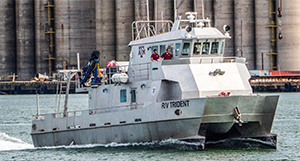As Capt. Steve Brown entered Bolivar Roads at the entrance to Galveston Bay, he opened up the Scania mains, propelling Texas A&M’s new 65-foot research and training vessel up to 22 knots, then demonstrated a very flat turn at speed.
R/V Trident was designed by Fyffe Yachts of Kemah, Texas, and built at Geo Shipyards in New Iberia, La., for the university’s Marine Education Department at Galveston. Although Trident is primarily a platform for marine science students, it is also designed to conduct independent research charters for other universities.
To that end, Capt. Allan Post, executive director of the school’s Marine Education Support and Safety Operations, explained that they deviated from the original design by moving the wet lab outside to the aft deck.
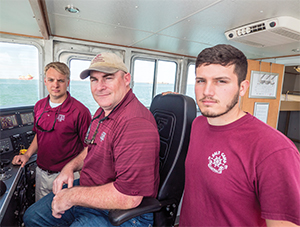 |
|
Gathering in the research vessel’s wheelhouse are student technician Mason Reininger, Capt. Steve Brown and biology student Austin Perez. |
“Then we turned the vacant space into the dry lab and converted what was to be the dry lab into bunks so that we could take on more scientists and technicians,” Post said.
So configured, Trident can carry eight scientists and four crew for up to five days without calling into port. The aft deck is equipped with a tie-down system and a moon pool. A DT Marine Products DT303EM survey/trawl winch feeds cable via a 3,000-pound aluminum A-frame on the stern, and there is a 500-pound swing davit arm on the port side for deploying side-mounted sonar. The transom on each pontoon has a hinged swim platform and ladder. Also on the upper deck is a 2-ton Toimil knuckle-boom crane with a 22.5-foot maximum reach and a 13-foot Carib RIB rescue boat.
The fully integrated bridge is equipped with a Furuno navigation and radar system and a Rose Point Navigation system coupled with the Simrad autopilot for running track lines to within 35 feet. “Usually it’s within 10 feet and the system gets cranky when it goes beyond that,” said Post.
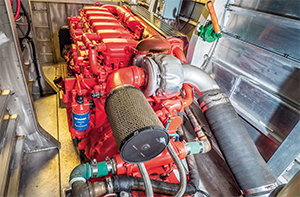 |
|
One of Trident’s two Scania D1-13-070M 500-hp main engines. |
Trident’s propulsion chain consists of twin 500-hp Scania D1-13-070M 13-liter diesel engines with ZF 360 marine gears at a 2.48:1 reduction ratio, connected to 32-by-42-inch ZF four-bladed nibral wheels. The vessel is fitted with two Wesmar V2 23-hp thrusters and two 33-kW Westerbeke gensets.
Brown slowed Trident to a cruising speed of 17 knots and headed the boat home to the Texas A&M waterfront operations dock on Pelican Island.
“She’s very efficient with the Scanias,” he said. “Right now we’re burning six gallons of fuel an hour. And she gets up and goes when you need to. And even in a strong wind she is pretty easy to moor. I usually use the spring line and the engines to moor the boat, but it’s nice to have the bow thrusters for backup when they are needed. They smooth things out if need be. But really, you can handle this boat with just the engines.”
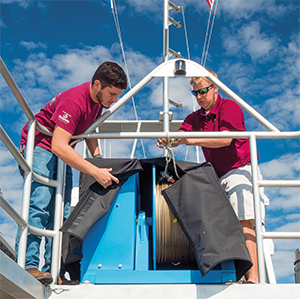 |
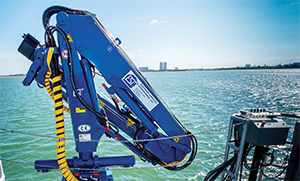 |
|
|
Perez and Reininger ready the vessel’s DT Marine Products DT303EM survey-trawl winch. |
Trident’s Toimil 2-ton knuckle-boom crane, with a maximum reach of 22.5 feet. |
|
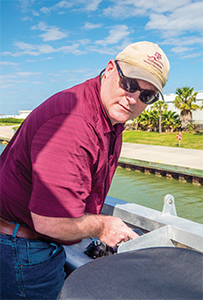 |
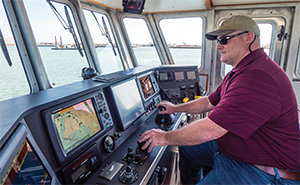 |
|
|
Brown maneuvers from the port bridge wing, one of the vessel’s four helm control stations. |
The captain is back in the wheelhouse, flanked by navigation and performance monitors, as Trident sails in Galveston Channel heading into Galveston Bay. |

